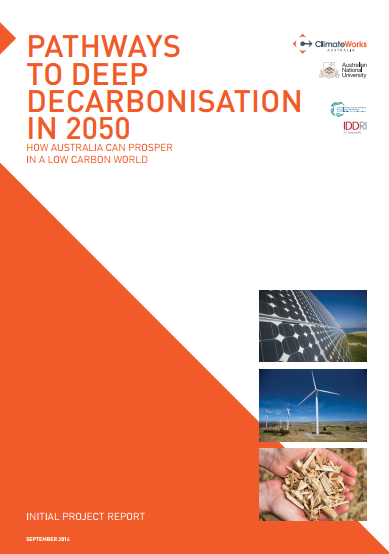A new report entitled Pathways to Deep Decarbonisation in 2050: How Australia can prosper in a low carbon world, released on the 23 September 2014, finds that Australia can achieve net zero emissions by 2050 and live within its carbon budget, without having to compromise its economic prosperity. CO2 capture and storage (CCS), among expansion of renewables and energy efficiency, will play a crucial role in exploiting these synergies between economy and environment.
ClimateWorks Australia and the Australian National University (ANU) have taken the lead in preparing this report for Australia as part of the 2050 Deep Decarbonisation Pathways Project (DDPP), coordinated by the Sustainable Development Solutions Network (SDSN). The DDPP aims to prepare transparent and practical national pathways to help countries adapt and implement policies to achieve deep decarbonisation. Moreover, the project aims to facilitate positive outcomes at 2014 UN Climate Summit as well as at the 2015 Conference of the Parties (COP-21) of the United Nations Framework Convention on Climate Change (UNFCCC). The ambitious decarbonisation plan for Australia presented by this report was developed using a combination of well-established modelling tools to identify feasible and least-costly options.
While some industries would have to undergo major technological transformations, no fundamental changes are required for Australia’s economy or lifestyle. In fact, the report finds that Australia can reach net zero emissions by 2050 while allowing the economy to continue growing at a similar rate as today – 2.4% of GDP per year. Australia’s decarbonisation pathway relies on greatly improved energy efficiency across the economy, what would be a nearly carbon free power system, and switching to low carbon energy sources in transport, buildings and industry. In addition to these three pillars that are common to all countries, Australia’s pathway also involves reducing non-energy emissions in industry and agriculture.
The report is positive in stating that technologies needed to make this decarbonisation possible are currently available or under development. In the electricity sector, for instance, multiple options are available to reach zero emissions. Removing CO2 from electricity is crucial in the Australian decarbonisation strategy and is easier than in many other countries, given the country’s great potential for renewable energy and CCS. Non-energy emissions from industry are reduced through substituting less emissions-intensive materials, process improvements and CCS.
A successful low carbon transition requires a thorough understanding of the options, opportunities and challenges. It also needs long-term policy signals to encourage the investment decisions needed for a decarbonised economy.
To read the report click here.




